Calcium supplements can relieve stress associated with PMS
Premenstrual syndrome (PMS) is a source of stress for many women. Symptoms of PMS include fatigue, irritability, abnormal bloating, breast tenderness, mood swings, and depression. For some women, exercise and a healthy diet are enough to take care of the problem. In severe cases, prescription drugs can be helpful (e.g., Prozac, Xanax, oral contraceptives). Lifestyle changes or prescription drugs are not an entirely satisfactory solution for all women, though. Another option is to take dietary supplements. Numerous dietary supplements have been advocated for this purpose, but there is little scientific evidence to support claims regarding their effectiveness. Accordingly, a researcher at SmithKline Beecham Consumer Healthcare recently reviewed the literature to find out which dietary supplements are backed by solid scientific evidence.
What was the research about?
So far, the beneficial effects of only one dietary supplement have received strong scientific support. Calcium, when taken at a dose of 1000 to 1200 milligrams per day, can substantially decrease many of the symptoms associated with PMS. Magnesium, vitamin E, and carbohydrate supplements may also be of some benefit, but the research findings are not as clear as they are for calcium supplements. There is not convincing evidence that vitamin B6, primrose oil, or herbal supplements are helpful. In fact, vitamin B6 in excess of 100 milligrams per day can be harmful and some herbal supplements should not be taken by women who may become pregnant or who are taking prescription drugs to treat severe PMS.
Why should it matter to me?
Women who experience stress as a result of PMS may want to consider taking calcium supplements.
Source: Bendich, A. (2000). The potential for dietary supplements to reduce premenstrual syndrome (PMS) symptoms. Journal of the American College of Nutrition, 19, 3-12.






